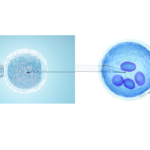What is PRP Treatment in IVF?
Introduction
The journey to parenthood is often filled with hope, and for many, In Vitro Fertilization (IVF) offers a significant step towards achieving that dream. As fertility science continues to advance, new and innovative treatments are constantly emerging to enhance IVF success rates. One such promising approach that has garnered considerable attention is Platelet-Rich Plasma (PRP) treatment. But what exactly is PRP, and how is it revolutionizing the field of reproductive medicine? Let’s delve deeper into this exciting development.
What is PRP?

To understand What is PRP Treatment in IVF, we first need to grasp the fundamental concept of PRP itself. Platelet-Rich Plasma (PRP) is a concentrated solution of platelets derived from your own blood. Platelets are tiny, disc-shaped cells primarily known for their role in blood clotting. However, they are also a powerhouse of growth factors – natural proteins that play a crucial role in tissue regeneration, repair, and healing.
The process of obtaining PRP is relatively straightforward. A small amount of blood is drawn from the patient, much like a routine blood test. This blood sample is then placed in a specialized device called a centrifuge, which spins at high speed. This spinning process separates the blood components, allowing the concentration of platelets and their beneficial growth factors into a small volume of plasma. The resulting solution, highly concentrated with these regenerative elements, is what we call Platelet-Rich Plasma. Because it uses the patient’s own blood, PRP is considered a very safe treatment with minimal risk of allergic reactions or disease transmission.
What is PRP Treatment in IVF?
In the realm of fertility, PRP in IVF is being explored as a complementary therapy to address specific challenges that can hinder successful conception. The underlying principle is to harness the regenerative and healing properties of the concentrated growth factors in PRP to improve the health and function of reproductive organs. These growth factors can stimulate cell growth, enhance blood flow, reduce inflammation, and promote tissue repair, all of which are vital for a successful pregnancy.
PRP is not a standalone IVF treatment but rather an adjunct used to optimize the conditions for embryo implantation and ovarian function in certain patient profiles. Its application focuses on two primary areas within IVF: ovarian rejuvenation and improving endometrial receptivity.
What is PRP Procedure in IVF?
The PRP Procedure in IVF involves the preparation of PRP, followed by its targeted administration into either the ovaries or the uterus, depending on the specific fertility challenge being addressed.
1. Ovarian PRP
Ovarian PRP, often referred to as “ovarian rejuvenation,” is considered for women with diminished ovarian reserve (DOR) or those who are poor ovarian responders during IVF cycles. The aim here is to potentially improve the quantity and quality of eggs.
- Procedure: After the PRP is prepared, it is carefully injected directly into the ovaries. This procedure is typically performed under ultrasound guidance, similar to an egg retrieval procedure during IVF. Light sedation or local anesthesia may be used to ensure patient comfort. The growth factors released by the platelets are believed to stimulate dormant follicles, improve blood supply to the ovaries, and enhance the overall ovarian environment, potentially leading to the development of healthier eggs.
2. Uterine PRP
Uterine PRP is primarily used to address issues related to the endometrial lining, which is crucial for embryo implantation. A thin or unresponsive endometrium can significantly reduce IVF success rates.
- Procedure: In this case, the prepared PRP is gently instilled into the uterine cavity using a thin, flexible catheter. This procedure is generally quick and resembles an intrauterine insemination (IUI). The growth factors in the PRP are thought to promote the growth and thickening of the endometrial lining, improve its receptivity to the embryo, and reduce any chronic inflammation that might be present. This is usually performed a few days before embryo transfer.
What are the benefits of PRP Fertility Treatment ?
The potential benefits of PRP Fertility Treatment are making it an increasingly popular option for couples facing specific fertility challenges.
1. Improve Ovarian Function
For women with low ovarian reserve or those who have had poor responses to previous IVF stimulations, ovarian PRP offers hope. The growth factors are believed to awaken dormant follicles, enhance the responsiveness of existing follicles to stimulation, and potentially improve egg quality. This can lead to a better yield of eggs during retrieval and a higher chance of creating viable embryos.
2. Enhance Pregnancy Rates
By improving both ovarian function and endometrial receptivity, PRP aims to directly contribute to higher pregnancy rates in IVF. A thicker, healthier uterine lining provides a more optimal environment for embryo implantation, and improved egg quality can lead to better embryo development, both of which are critical for a successful pregnancy outcome. While research is ongoing, many clinics are reporting positive results, especially in cases of recurrent implantation failure due to thin endometrium.
3. Natural and Safe
One of the most significant advantages of PRP is its natural and safe profile. Since the treatment utilizes the patient’s own blood, there is virtually no risk of allergic reactions or rejection. This makes it a highly biocompatible option, minimizing concerns about adverse effects commonly associated with synthetic substances.
What are the PRP IVF Side Effects?
While PRP is generally considered safe, like any medical procedure, there can be some minor PRP IVF Side Effects. These are typically mild and transient:
1. Pain
Patients may experience mild discomfort or a dull ache at the site of blood collection or the injection site (ovaries or uterus). This is usually manageable with over-the-counter pain relievers.
2. Discomfort at the Injection Site
Following the ovarian or uterine injection, some patients might feel temporary discomfort, similar to mild cramping. This usually subsides within a few hours to a day.
3. Bruising
Minor bruising can occur at the blood draw site or the injection site, which resolves on its own within a few days.
4. Swelling
Localized swelling at the injection site is also a rare but possible side effect, which typically subsides quickly.
Serious complications such as infection are extremely rare due to the sterile techniques employed during the procedure. It’s crucial to discuss any concerns or pre-existing conditions with your fertility specialist.
Conclusion
The journey to parenthood is a deeply personal one, and at Iris IVF Centre, we understand the emotional and physical aspects of this path. What is PRP Treatment in IVF is a question many are now asking, and it represents a significant advancement in offering renewed hope for those facing specific fertility challenges. By harnessing the body’s own regenerative capabilities, PRP has shown promise in improving ovarian function and endometrial receptivity, thereby potentially enhancing IVF success rates.
While more extensive research continues to unfold, the initial outcomes are encouraging, positioning PRP as a valuable complementary therapy in the landscape of assisted reproductive technologies.
If you are exploring advanced fertility solutions and wish to understand if PRP treatment is suitable for your unique situation, look no further. Iris IVF Centre stands as the best IVF clinic for IVF treatments in Mumbai. With a team of highly experienced fertility specialists, state-of-the-art technology, and a compassionate approach to patient care, we are dedicated to providing personalized and effective fertility solutions. Our commitment to excellence and our patient-centric philosophy ensure that you receive the best possible care on your journey to parenthood. Contact Iris IVF Centre today to schedule a consultation and take the next step towards realizing your dream.
Dreaming of a Family?
Iris IVF Centre is Your Partner in Parenthood! Contact us today for a personalized consultation and begin your IVF journey!
FAQs
1. What does PRP do for IVF?
PRP in IVF aims to improve ovarian function by potentially activating dormant follicles and enhancing egg quality, and it also works to improve the uterine lining’s thickness and receptivity, creating a more favorable environment for embryo implantation.
2. Is PRP in IVF painful?
The PRP procedure generally involves minimal discomfort. The blood draw is similar to a routine test. For ovarian PRP, light sedation is typically used to ensure comfort during the injection. Uterine PRP may cause mild cramping, similar to an IUI.
3. What is the success rate of PRP in IVF?
While research is ongoing, preliminary studies and clinical observations suggest promising results, particularly for thin endometrium and poor ovarian responders. Success rates vary depending on individual patient factors and the specific fertility challenge being addressed. It’s best to discuss the latest data and your individual prognosis with your fertility specialist.
4. Can I get pregnant after PRP?
PRP is a complementary treatment to IVF. It aims to improve the conditions for successful pregnancy by enhancing ovarian function and uterine receptivity. Many patients who undergo PRP treatment alongside their IVF cycles have reported positive outcomes and successful pregnancies.
5. What are the PRP IVF success rates?
Success rates for PRP IVF are still being evaluated through ongoing research. Anecdotal evidence and smaller studies suggest improvements in endometrial thickness, ovarian response, and clinical pregnancy rates in specific patient populations. For personalized information, consulting with a fertility expert is recommended.


